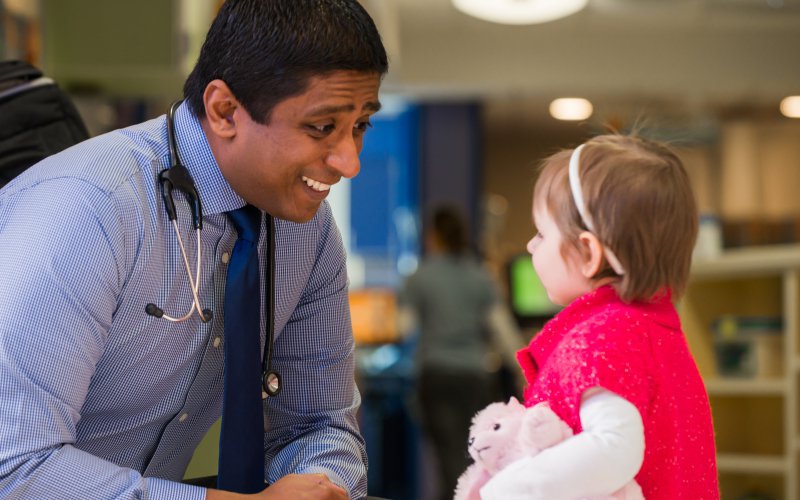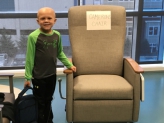
By: Trish Adkins
When Beth Cook’s then 8-year-old son Travis was diagnosed with childhood cancer, she did not know what to say.
The diagnosis came after Travis hit his head really hard and Beth thought he had a concussion. An MRI revealed there was no concussion, but there was cancer in the form of a diffuse and inoperable brain tumor.
“I did not know what to tell Travis, but I had to tell him,” recalls Beth. “I told him there was something in his head that didn't belong there, but it was going to be ok because he had the best doctors in the world taking care of him. I didn't know if that was the right thing to say, but it comforted him. I was a lot less confident than I showed.”
The story is similar for most childhood cancer families — the diagnosis is a shock and parents are left struggling with the right words to tell their child and then later their siblings, friends and classmates.
We spoke with pediatric oncology social workers, child life specialists and childhood cancer families. Here are their seven tips for talking to kids about cancer:
1. Call it what it is: Cancer.
The hardest step is saying cancer for the first time.
For both children who are diagnosed and the children closest to them, using medically correct terms is important, according to Amanda Welk, a Child Life Specialist at Children’s Mercy Hospital in Kansas City.
“We encourage the use of the correct terminology. If you use another term in an effort to make your child less scared, it can backfire,” said Welk. “It is scary if kids overhear you use the word cancer, if you haven’t used it with them before.”
When Miriam Matz’s daughter Ellie was diagnosed at 5 years old with acute lymphoblastic leukemia (ALL), she did her best to give Ellie and her sisters (then 9 and 4 years old) all the information that was appropriate for their ages. Ellie had been feeling ill for weeks prior to diagnosis. Discussing what made her sick and how the doctors would treat Ellie gave her sisters a context to better understand the situation.
2. Honor Ages and Stages
“Would she die?” Miriam’s oldest daughter had more of an understanding of what cancer was and immediately asked some pretty tough questions like this one. Her youngest daughter was most concerned with when her sister would come home again.
The team in the Siblings Program at Dana-Farber Boston Children’s Cancer and Blood Disorders Center recommends meeting children where they are developmentally. Children who are 2-5 years old may only have a basic understanding of illness and may even think cancer is contagious. Keep explanations simple for this age group and explain exactly what to expect.
Older children may have heard about cancer before, but most likely do not understand the details. Experts suggest beginning conversations with leading questions to gauge their knowledge and open the door to deeper discussions.
For tweens and teens that may have a deeper knowledge of the seriousness of cancer, start with the basics and elaborate as it feels appropriate. Older children might not come to you with their fears and worries, so encourage them to reach out to trusted adults like teachers, parents or school counselors.
3. Be honest, even with the tough questions.
Talking about childhood cancer, especially to those directly affected, is never an easy conversation. Like Miriam’s oldest daughter, children will have some tough questions. They might ask: “Why did this happen?” or “If this happened to my sister, will this happen to me?”
Instead of looking for answers that might provide comfort, aim for honesty, says Welk. To answer the question, “Why did this happen?” respond by saying “I don’t know. It makes me sad, too.” To answer, “Will the medicine work?” say “Our plan is to take this medicine. For a lot of kids this works, so let’s stay positive.”
You can also tap into your hospital’s team for support during these difficult conversations.
4. Let kids guide the conversation.
No matter their age, let your kids guide the conversation, says Kelly Goldin, a Child Life Specialist at Children’s Hospital of Philadelphia. Kelly, who often works with siblings of children battling cancer, always watches for cues to determine whether they’ve had enough of the conversation or if they need to know a little more.
“I always make sure I am paying attention to the child’s body language and other cues that may tell me that they need a break,” said Kelly. “For example, when a child asks if they can go play during diagnosis teaching, I honor their request. It’s a sign to me that they aren’t able to process all the information we are talking about. And since play is fun and normal, I want to make sure I find that balance with them.”
If children are asking questions and seem to be engaged in the moment, keep talking. If they are finished with the conversation, don’t abandon it forever. It is important to keep the dialogue going, but at their pace.
5. Educating classmates can help support a child’s return to school.
Childhood cancer can sometimes leave children looking dramatically different than they did before. There can be scars from surgery or weight gain or loss from treatment. And of course, sometimes treatments can cause a child to lose their hair.
Welk suggests working with the school guidance counselor and nurse to educate classmates about childhood cancer, the treatment your child had and what to expect. You can also develop an action plan at school — so your child can easily cue a teacher to support them when they’ve had enough of discussing cancer. If your child does not want to answer any questions, ask the school to designate someone who can be present for questions from classmates.
6. Remember you are not alone.
Dara Dandrea-Giannotti, mom to childhood cancer hero Grace and SuperSib Cecilia, said Cecilia, who was 5 years old at the time of her sister’s diagnosis, found friendships and a safe place to express all the complicated emotions childhood cancer brings at their hospital’s sibling support group. That group has helped Cecilia through her sister’s treatment, relapse and side effects.
It is extremely difficult for both parents and children to explain to other people how a childhood cancer diagnosis has affected them. This is normal, says Welk. But, making connections with other families dealing with similar diagnoses can help with feelings of isolation and loneliness.
For friends and families of childhood cancer heroes, Welk reminds everyone not to shy away or be worried that you don’t know the right thing to say. The time during diagnosis and treatment is when your loved ones need you the most. You can also reach out to professionals for advice on how to communicate and provide support.
7. In the end, kids are just kids.
When a child is diagnosed with cancer, they don’t cease being a child. Sometimes in the chaos of treatment, this can get lost. While it is important to talk about cancer, it is also important to talk about normal stuff too.
“Everything is so out of control. So if there are things you can hold steady, hold them steady,” said Tommi McHugh, a child life specialist and educator at Children’s Hospital of Colorado.
McHugh says letting your kids be kids through cancer treatment not only makes them feel like themselves; but also makes them feel in control. All children can benefit from being with friends, making choices and being allowed to feel all the emotions that are normal—happy, sad, angry, and even goofy too.
Looking for more resources? Alex’s Lemonade Stand Foundation (ALSF) provides several resources to support families, friends and schools through childhood cancer diagnosis, treatment and beyond, including our SuperSibs program and our school support program, which provides school professionals tools to address the needs of the school community. Schools can receive a copy of the ALSF School Guide: Supporting Families and Classmates Affected by Childhood Cancer. Available as both an e-book and as a soft-cover book, it offers concise, practical guidance including:
• Establishing effective communication between home, school, and healthcare professionals
• Navigating conversations with students in the classroom
• Providing an easier transition back to school
• Offering extra support to siblings of childhood cancer patients
• Encouraging a positive atmosphere for the whole classroom
• Supporting classmates through grief and loss

